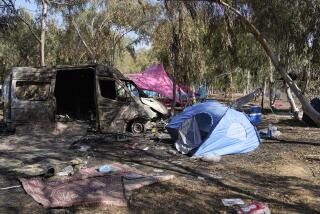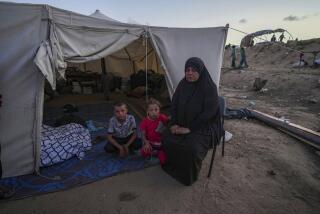Rudolf Vrba, 81; Auschwitz Escapee Gave 1st Details of Nazi Atrocities
- Share via
Rudolf Vrba, one of the few prisoners to escape from Auschwitz during World War II and the coauthor of the first eyewitness report detailing the extent of the atrocities there, has died. He was 81.
Vrba, who is was credited with saving the lives of more than 100,000 fellow Jews, most of them Hungarians, died March 27 of cancer at a hospital in Vancouver, Canada.
Part of the Sonderkommando, the special unit assigned to dispose of the bodies of those killed in the mass extermination, Vrba had firsthand knowledge of the brutality at Auschwitz, where more than 1 1/2 million people were killed.
“Vrba’s experience as a Sonderkommando was key to the report having the authority that it did,” said Bernie M. Farber, chief executive officer of the Canadian Jewish Congress. “Rudy had a picture-perfect mind, and he remembered the languages that [the prisoners] spoke and he knew how many could be crammed into a railroad car.”
Vrba, who coauthored the report with fellow prisoner Alfred Wetzler, said he escaped from the camp in southern Poland to save lives.
“The strength of the Final Solution was its secrecy,” Vrba told the Ottawa Citizen last year. “I escaped to break that belief that it was not possible. And to stop more killings.”
Vrba was born Walter Rosenberg in Topolcany, Czechoslovakia. He was working as a laborer in March 1942 when he was taken into custody because he was Jewish.
Two months later, Vrba, then 18, was deported and -- after an initial stop at another concentration camp -- reached Auschwitz on June 30, 1942.
By midsummer he had been assigned to a work detail that sorted possessions confiscated from prisoners. In June 1943, he was given the job of registrar in the quarantine section of the death camp. His last detail at Auschwitz was as a Sonderkommando.
Vrba’s photographic memory enabled him to retain much of the geography and the placement of the facilities as he went about his work. He also reportedly heard guards talking about the impending arrival of a new shipment of inmates that they termed “Hungarian sausage.” He took this conversation to mean Hungarian Jews, the last Jewish population in Europe to be deported. In April 1944, with the help of the camp underground, Vrba and Wetzler planned their escape. The men hid in a woodpile outside the camp’s barbed-wire inner perimeter.
They knew that guards generally searched for missing prisoners for three days before giving up. After the third day, they made their way into the countryside, using a page from a children’s torn atlas as a guide. Eight days later they crossed the border into Slovakia and found underground members who would help them.
Working with local Jewish leaders, the two men prepared a 32-page report that offered a precise description of the geography of Auschwitz, including diagrams locating the gas chambers and crematories in that area of the camp known as Birkenau. The report also detailed how the selection of prisoners -- who would be sent to the gas chambers and who would be assigned to work duty -- was carried out.
By late April 1944, the report was on its way to members of the Jewish underground in Hungary. A copy of the report was sent to the Vatican in late May and by mid-June officials of the U.S. and British governments had copies as well.
On May 27, two other prisoners escaped Auschwitz and arrived in Slovakia in early June. They said that despite the warnings in the Vrba-Wetzler report, tens of thousands of Hungarian Jews had begun arriving at Auschwitz in mid-May and were being put to death. Their account of activities at the camp was combined with the Vrba-Wetzler findings to create what became known as the Auschwitz Protocol.
Bowing to world pressure generated by the eyewitness accounts and perhaps fearful of postwar retribution, Hungarian officials stopped the deportation of Jews in July 1944.
Vrba became a member of the Slovak partisans and fought until the end of the war. He took the name Rudolf Vrba while fighting the Nazis and had it legalized.
After the war, he studied chemistry in Prague. He earned his doctorate by 1951. As a researcher, his specialty was brain chemistry. He also worked on diabetes and cancer. He lived in Israel and then England before immigrating to Canada in the 1970s, where he became a professor of pharmacology at the University of British Columbia.
Wetzler, who coauthored the report, died in Slovakia in 1988.
Vrba is survived by his wife, Robin; a daughter, and two grandchildren.
He wrote a book of personal recollections, “I Cannot Forgive,” which was published in 1964, and he contributed to four documentary films, including 1985’s “Shoah.”
To the end, however, Vrba believed that his report did not save enough lives and he was critical of Jewish officials in Hungary for not giving it wider distribution.
In 1998, he was awarded an honorary doctorate in philosophy by the University of Haifa.
Upon learning of Vrba’s death, Ruth Linn, dean of education at the University of Haifa and author of “Escaping Auschwitz: A Culture of Forgetting,” a book about Vrba’s experiences, called him an “exemplary courageous hero and warrior.”
“We have lost a rare history maker that the history tellers are yet to find the right words to describe.”
More to Read
Sign up for Essential California
The most important California stories and recommendations in your inbox every morning.
You may occasionally receive promotional content from the Los Angeles Times.










